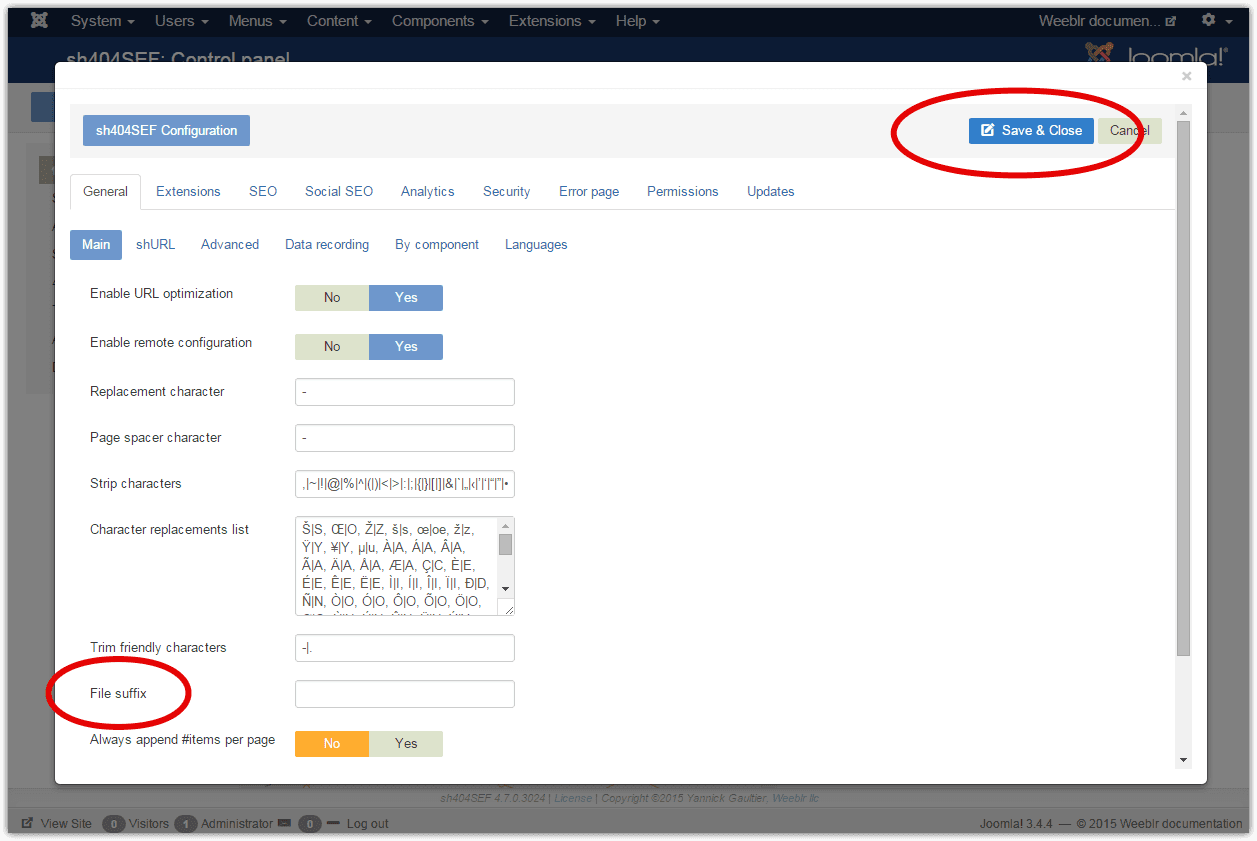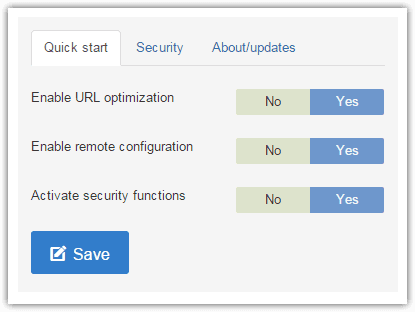sh404SEF basic settings
sh404SEF is a Joomla-3 only extension. It will be/has been discontinued on August 17, 2023.
You can switch from sh404SEF to 4SEF for SEF URLS and 4SEO for an all-in-one Joomla SEO extension, which both run on Joomla 3 and Joomla 4.
Please refer to the sh404SEF FAQ page for more details.
1 - Optional: Append suffix
If you selected to append a "html" suffix in your Joomla! SEF URL configuration, you should do the same in sh404SEF. Click on the Configuration button in the toolbar of any of sh404SEF backend page, and the configuration popup will open:

Enter ".html" in the File suffix input field (with a "." at the beginning), then press the Save and close button.
Though sh404SEF is theoretically capable of handling other suffixes than "html", such as "htm" or even "php", it is recommended to stick with the "html" suffix, which will provide maximum compatibility with Joomla! itself and other extensions.
As a matter of fact, and unless you want to maintain compatibility with existing URLs on your site, we recommend to not add any one. A suffix increases URL length without bringing any value.
2 - Enable sh404SEF
The few settings to enable sh404SEF are on this screenshot:

a - Set URL optimization to Yes
This should match what you selected when you activated SEF URLs in Joomla! global configuration.
b - Click on Save button
As soon as you click the Save button, URLs on the front end of your site will be modified by sh404SEF. If some of your pages are already indexed by search engines, or bookmarked by past visitors, you must setup a redirect strategy.
There are several ways to handling changing URLs. Most often, you'll try redirect old URLs to new ones:
- using your .htaccess file (or similar for your web server)
- using sh404SEF automatic redirect feature
- using sh404SEF manually created aliases
The simplest option is to make sure the 301 redirect from Joomla SEF to sh404SEF is enabled (it should be enabled by default, under the Advanced tab of sh404SEF configuration). This will cause sh404SEF to redirect old Joomla SEF URLs to their sh404SEF equivalent. You can create manually aliases for special cases that would not be handled properly by the automatic redirect feature.
Another option is to not perform any redirect, but instead use sh404SEF to create canonical tags
You may also manually customize some URLs so that they become identical to old ones, if you prefer to not have any redirects.
Lastly, you can enable sh404SEF 404 auto-redirect feature, which will attempt to redirect automatically 404 pages to the closest existing URL on the site.
All features in sh404SEF, except security, require URL optimization to be enabled. It's a general On/Off switch that you can use to disable it when you want to test or compare what happens on your site with or without it.
sh404SEF will comply with the Joomla Use URL rewriting setting we have mentioned on the previous page.
3 - Optional: Enable security features
This is one of the setting in the screenshot above. Security functions include a simple firewall, anti-spam protection, anti-flooding and more, and is covered elsewhere in this documentation.
4 - Optional: Enable remote configuration
This setting, also visible on the screenshot above, will make sh404SEF load a configuration file from one of our server, with generic technical configuration. That way we may be able to update some configuration options without having to release a new version (and you having to install it).
Information covered by this remote configuration are for instance the address of the update server, list of common Adwords or Analytics tracking vars, up to date search engines bots user agent strings or mobile user agents strings.
When enabled, remote configuration is fetched at most once per hour. The remote configuration file lives at http://u1.weeblr.com/public/direct/sh404sef/config/sh404sef_config.xml.